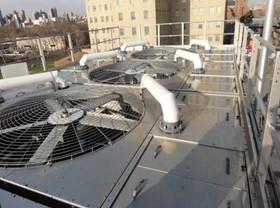Into the Mist - Staying Ahead of Legionella in Building Water Systems
Posted April 5, 2022
Building water systems can present an ideal environment for the growth of bacteria, including Legionella bacteria, the bacteria that causes Legionellosis (Legionnaires' Disease and Pontiac Fever). Legionella pneumophila is the primary bacterium in the Legionella genus that causes Legionellosis. You may be exposed if you breathe in water vapor containing Legionella bacteria. The Centers for Disease Control and Prevention (CDC) studied Legionnaires' Disease outbreaks from 2000 to 2014 and found many outbreaks could have been prevented. During that time, the CDC studied 27 outbreaks to determine the source and deficiencies that contributed to the outbreak. They found that potable water was the source in 56% of the outbreaks, cooling towers caused 22%, and hot tubs caused 7%. The remaining outbreaks were caused by industrial equipment, decorative fountains, water features, or unidentified sources (Garrison LE, 2016, p. 578). Best practices are essential to minimize bacterial growth in building water systems and prevent significant health risks due to Legionella exposure.
Contributing Factors
The CDC identified contributing factors in 23 of the outbreaks. Approximately 65% were due to process failures, such as not having a building water system management program (Garrison LE, 2016, p. 579). With this in mind, the source for Legionnaires cases is much more likely to be from a buildings' drinking water system, where exposure points such as water fountains, sinks, ice machines, and showers are common. Therefore, having a Building Water System Management Plan is necessary to prevent Legionella from occurring within the building water system.
 |
After completing the investigation, the CDC issued a guidance document to assist facilities in developing water management programs to reduce Legionella growth entitled "Developing a Water Management Program to Reduce Legionella Growth and Spread in Buildings: A Practical Guide to Implementing Industry Standards."
CHA Consulting, Inc. (CHA) uses CDC resources, as well as the American Society of Heating, Refrigerating, and Air-Conditioning Engineers (ASHRAE) Standard 188-2018, entitled "Legionellosis: Risk Management for Building Water Systems," and ASHRAE Standard 12-2020, entitled "Managing the Risk of Legionellosis Associated with Building Water Systems," to develop Building Water System Management Plans. ASHRAE Standard 188-2018 provides minimum components to include in a plan, and 12-2020 describes how to develop an effective water management plan.
CHA's Process
CHA's process includes reviewing the building domestic water piping system to develop a flow diagram and to understand the system thoroughly. Water system measurements are then collected for chlorine residual, pH, temperature, and turbidity. The condition of the current water treatment systems is then reviewed and evaluated. An Environmental Assessment Form (EAF) is then completed for each building to identify plumbing features and areas of risk. CHA uses this information to develop a Building Water System Management Plan, which includes:
- Description of the building water supply
- Description of the domestic water delivery system and uses, such as showers, sinks, fountains, ice machines, and cooling towers
- Profile of the water quality throughout the building
- Environmental Assessment Form (EAF)
- Procedures for Legionella remediation and prevention
- Water sampling procedures
- Recordkeeping requirements
.jpg) Mitigating Your Risks
Mitigating Your Risks
Legionella remedial options include ultraviolet, superheating, and hyper-halogenation. However, CHA recommends system flushing as a new remedial approach and the preferred remedial option in our plans. There is a risk of exposure to unsafe temperatures and high chlorine levels with two of the common remedies. Further, flushing is a significantly cheaper alternative compared to ultraviolet, superheating, and hyper-halogenation options. Flushing procedures allow clean chlorinated water from the municipal water supply to reach the entire system. Our method is based on a study published in Applied and Environmental Microbiology that found that 0.5 ppm total chlorine will eliminate 99% of Legionella pneumophila within approximately five minutes (Kuchta, 1983, p. 1136). CHA has successfully used this option at several client locations.
Regular system flushing is an easy process to implement and maintain and will reduce the potential for bacteria growth. CHA recommends flushing if a water system has been unused (stagnant) for three or more weeks and can provide training to facility maintenance staff during initial flushing activities so the facilities themselves can manage future flushing activities and reduce costs.
CHA recommends that all building owners develop a Building Water System Management Plan to reduce the potential for Legionellosis in their building water system. Six out of ten Legionellosis cases have been linked to a potable water supply. CHA's flushing remedy is more cost-effective than installing and maintaining costly ultraviolet or hyper-halogenation systems and is more cost-effective to maintain than superheating. Our flushing remedy is also much safer to implement than all three of the other options. Once the plan is developed and training is provided to maintenance staff, it could be managed internally to reduce cost if desired.
Conclusion
It is essential to have a Building Water System Management Plan to prevent Legionella growth and protect building occupants. By maintaining a long-term water management program and reviewing your plan annually under certain conditions, you will mitigate risk and prevent the spread of Legionella in your building water systems.
Citations
Garrison LE, K. J. (2016). Deficiencies in Environmental Control Identified in Outbreaks of Legionnaires' Disease. Vital Signs, 576-584.
Kuchta, J. S. (1983). Susceptibility of Legionella pneumophilia to Chlorine in Tap Water. Applied and Environmental Microbiology, 1134-1139.
References
American Society of Heating, Refrigerating, and Air-Conditioning Engineers Standard 188-2018, Legionellosis: Risk Management for Building Water Systems https://www.ashrae.org/technical-resources/bookstore/ansi-ashrae-standard-188-2018-legionellosis-risk-management-for-building-water-systems
American Society of Heating, Refrigerating, and Air-Conditioning Engineers Standard 12-2020, Managing the Risk of Legionellosis Associated with Building Water Systems https://www.techstreet.com/ashrae/standards/guideline-12-2020-managing-the-risk-of-legionellosis-associated-with-building-water-systems?product_id=2111422
Centers for Disease Control and Prevention (2021) Developing a Water Management Program to Reduce Legionella Growth and Spread in Buildings: A Practical Guide to Implementing Industry Standards https://www.cdc.gov/legionella/downloads/toolkit.pdf